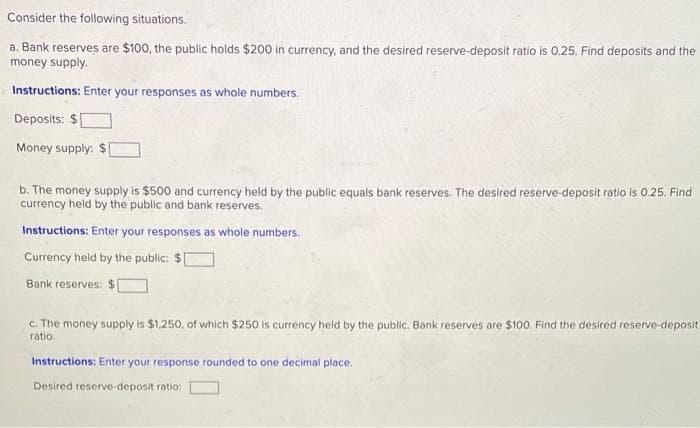Lonsider the following situations. a. Bank reserves are $100, the public holds $200 in currency, and the desired reserve-deposit ratio is 0.25. Find deposits and th money supply. Instructions: Enter your responses as whole numbers. Deposits: Money supply: $ b. The money supply is $500 and currency held by the public equals bank reserves. The desired reserve-deposit ratio is 0.25. Fine currency held by the public and bank reserves. Instructions: Enter your responses as whole numbers. Currency held by the public: $1 Bank reserves: C. The money supply is $1,250, of which $250 is currency held by the public. Bank reserves are $100. Find the desired reserve-depo ratio. Instructions: Enter your response rounded to one decimal place. Desired reserve-deposit ratio:
Lonsider the following situations. a. Bank reserves are $100, the public holds $200 in currency, and the desired reserve-deposit ratio is 0.25. Find deposits and th money supply. Instructions: Enter your responses as whole numbers. Deposits: Money supply: $ b. The money supply is $500 and currency held by the public equals bank reserves. The desired reserve-deposit ratio is 0.25. Fine currency held by the public and bank reserves. Instructions: Enter your responses as whole numbers. Currency held by the public: $1 Bank reserves: C. The money supply is $1,250, of which $250 is currency held by the public. Bank reserves are $100. Find the desired reserve-depo ratio. Instructions: Enter your response rounded to one decimal place. Desired reserve-deposit ratio:
Brief Principles of Macroeconomics (MindTap Course List)
8th Edition
ISBN:9781337091985
Author:N. Gregory Mankiw
Publisher:N. Gregory Mankiw
Chapter11: The Monetary System
Section: Chapter Questions
Problem 2PA
Related questions
Question

Transcribed Image Text:Consider the following situations.
a. Bank reserves are $100, the public holds $200 in currency, and the desired reserve-deposit ratio is 0.25. Find deposits and the
money supply.
Instructions: Enter your responses as whole numbers.
Deposits: $
Money supply:
b. The money supply is $500 and currency held by the public equals bank reserves. The desired reserve-deposit ratio is 0.25. Find
currency held by the public and bank reserves.
Instructions: Enter your responses as whole numbers.
Currency held by the public: $
Bank reserves:
c. The money supply is $1,250, of which $250 is currency held by the public. Bank reserves are $100. Find the desired reserve-deposit
ratio.
Instructions: Enter your response rounded to one decimal place.
Desired reserve-deposit ratio:
Expert Solution
This question has been solved!
Explore an expertly crafted, step-by-step solution for a thorough understanding of key concepts.
This is a popular solution!
Trending now
This is a popular solution!
Step by step
Solved in 2 steps

Knowledge Booster
Learn more about
Need a deep-dive on the concept behind this application? Look no further. Learn more about this topic, economics and related others by exploring similar questions and additional content below.Recommended textbooks for you

Brief Principles of Macroeconomics (MindTap Cours…
Economics
ISBN:
9781337091985
Author:
N. Gregory Mankiw
Publisher:
Cengage Learning

Principles of Economics (MindTap Course List)
Economics
ISBN:
9781305585126
Author:
N. Gregory Mankiw
Publisher:
Cengage Learning

Principles of Macroeconomics (MindTap Course List)
Economics
ISBN:
9781305971509
Author:
N. Gregory Mankiw
Publisher:
Cengage Learning

Brief Principles of Macroeconomics (MindTap Cours…
Economics
ISBN:
9781337091985
Author:
N. Gregory Mankiw
Publisher:
Cengage Learning

Principles of Economics (MindTap Course List)
Economics
ISBN:
9781305585126
Author:
N. Gregory Mankiw
Publisher:
Cengage Learning

Principles of Macroeconomics (MindTap Course List)
Economics
ISBN:
9781305971509
Author:
N. Gregory Mankiw
Publisher:
Cengage Learning

Essentials of Economics (MindTap Course List)
Economics
ISBN:
9781337091992
Author:
N. Gregory Mankiw
Publisher:
Cengage Learning

Macroeconomics: Private and Public Choice (MindTa…
Economics
ISBN:
9781305506756
Author:
James D. Gwartney, Richard L. Stroup, Russell S. Sobel, David A. Macpherson
Publisher:
Cengage Learning

Economics: Private and Public Choice (MindTap Cou…
Economics
ISBN:
9781305506725
Author:
James D. Gwartney, Richard L. Stroup, Russell S. Sobel, David A. Macpherson
Publisher:
Cengage Learning